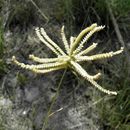Comprehensive Description
provided by North American Flora
Chloris cucullata Bisch. Ann. Sci. Nat. Bot. III. 19: 357. 1853
Perennial; culms 15 (rarely 10 cm.)-65 cm. tall, usually erect, sometimes decumbent at the base and rooting at the lowermost nodes; sheaths compressed-keeled, glabrous or scaberulous, the hyaline margins often conspicuous; ligule 0.5 mm. long, very minutely ciliate; blades flat, conduplicate at the base, 5-25 cm. long (mostly 8-15 cm.), 1.5-3 mm. wide, scabrous on both surfaces or the lower glabrous except on the midnerve, the margins very scabrous; spikes 6-15, 3-5 cm. long, usually flexuous, ascending, spreading or some of them even reflexed, arranged in two or three approximate whorls, the rachis scabrous, densely pubescent at tlie base; spikelets 1.5-2 mm. long; glumes broad, I-nerved, scabrous on the keel, the first subobtuse, 0.8-1 mm. long, the second acute, 1.3-1.5 mm. long, sometimes mucronate; fertile floret 1.5-1.8 mm. long, obovate, the lemma shortly pilose on the keel and margins, mucronate or usually with an awn 1-2 mm. long; rudiment conspicuous, inflated, much broader than long, mucronate or with an awn 1-2 mm. long.
Type locality; Matamoros, Tamaulipas.
Distribution: Open sandy plains and waste places, Texas, New Mexico, and northeastern Mexico (type only).
- bibliographic citation
- Albert Spear Hitchcock, Jason Richard Swallen, Agnes Chase. 1939. (POALES); POACEAE (pars). North American flora. vol 17(8). New York Botanical Garden, New York, NY
Physical Description
provided by USDA PLANTS text
Perennials, Terrestrial, not aquatic, Stems nodes swollen or brittle, Stems erect or ascending, Stems caespitose, tufted, or clustered, Stems terete, round in cross section, or polygonal, Stem internodes solid or spongy, Stems with inflorescence less than 1 m tall, Stems, culms, or scapes exceeding basal leaves, Leaves mostly cauline, Leaves conspicuously 2-ranked, distichous, Leaves sheathing at base, Leaf sheath mostly open, or loose, Leaf sheath smooth, glabrous, Leaf sheath or blade keeled, Leaf sheath and blade differentiated, Leaf blades linear, Leaf blades 2-10 mm wide, Leaf blades mostly flat, Leaf blades mostly glabrous, Leaf blades scabrous, roughened, or wrinkled, Ligule present, Ligule a fringed, ciliate, or lobed membrane, Inflorescence terminal, Inflorescence solitary, with 1 spike, fascicle, glomerule, head, or cluster per stem or culm, Inflorescence a panicle with narrowly racemose or spicate branches, Inflorescence a panicle with digitately arranged spicate branches, Inflorescence branches more than 10 to numerous, Inflorescence branches 1-sided, Lower panicle branches whorled, Inflorescence branches paired or digitate at a single node, Flowers bisexual, Spikele ts sessile or subsessile, Spikelets laterally compressed, Spikelet less than 3 mm wide, Spikelets with 1 fertile floret, Spikelets solitary at rachis nodes, Spikelets all alike and fertille, Spikelets bisexual, Spikelets disarticulating above the glumes, glumes persistent, Spikelets disarticulating beneath or between the florets, Rachilla or pedicel glabrous, Glumes present, empty bracts, Glumes 2 clearly present, Glumes distinctly unequal, Glumes shorter than adjacent lemma, Glumes keeled or winged, Glumes 1 nerved, Lemma similar in texture to glumes, Lemma 3 nerved, Lemma body or surface hairy, Lemma apex truncate, rounded, or obtuse, Lemma awnless, Lemma mucronate, very shortly beaked or awned, less than 1-2 mm, Lemma margins thin, lying flat, Lemma straight, Palea present, well developed, Palea shorter than lemma, Palea 2 nerved or 2 keeled, Stamens 3, Styles 2-fid, deeply 2-branched, Stigmas 2, Fruit - caryopsis, Caryopsis ellipsoid, longitudinally grooved, hilum long-l inear.
Chloris cucullata: Brief Summary
provided by wikipedia EN
Chloris cucullata is a species of grass known by the common name hooded windmill grass. It is native to the United States, particularly the states of Texas and New Mexico, and adjacent Mexico.
This is a clump-forming perennial grass with erect stems up to 60 centimeters tall. The leaf blades are up to 20 centimeters long, the longer ones located around the base. The panicle contains whorls of spikelets, each whorl with several branches up to 5 centimeters long. The branches are purplish, drying brown.
- license
- cc-by-sa-3.0
- copyright
- Wikipedia authors and editors

